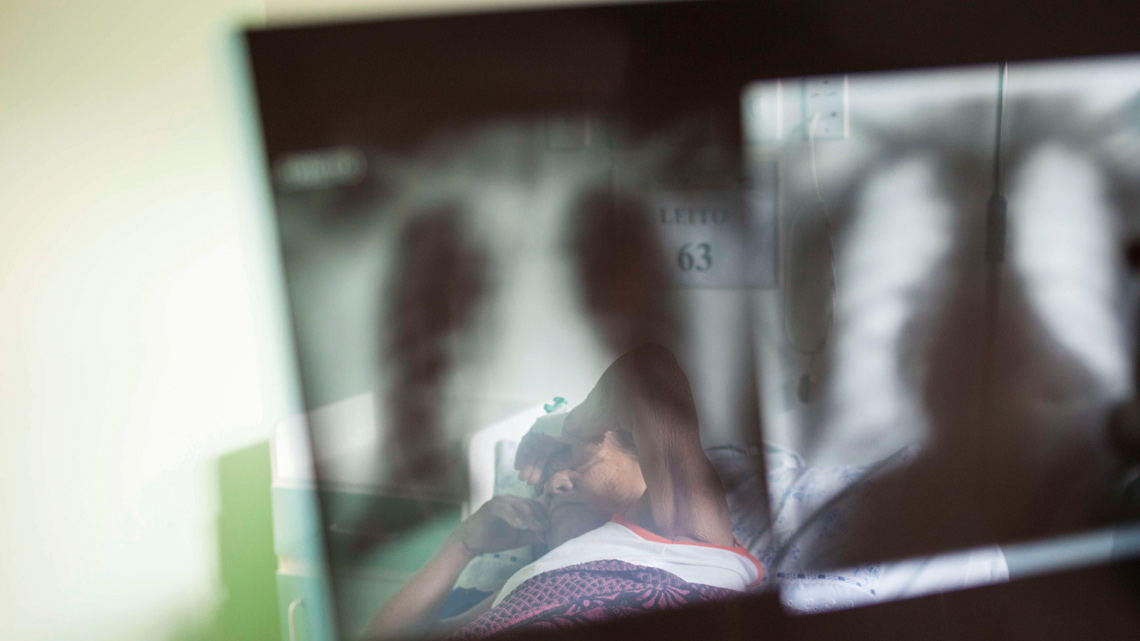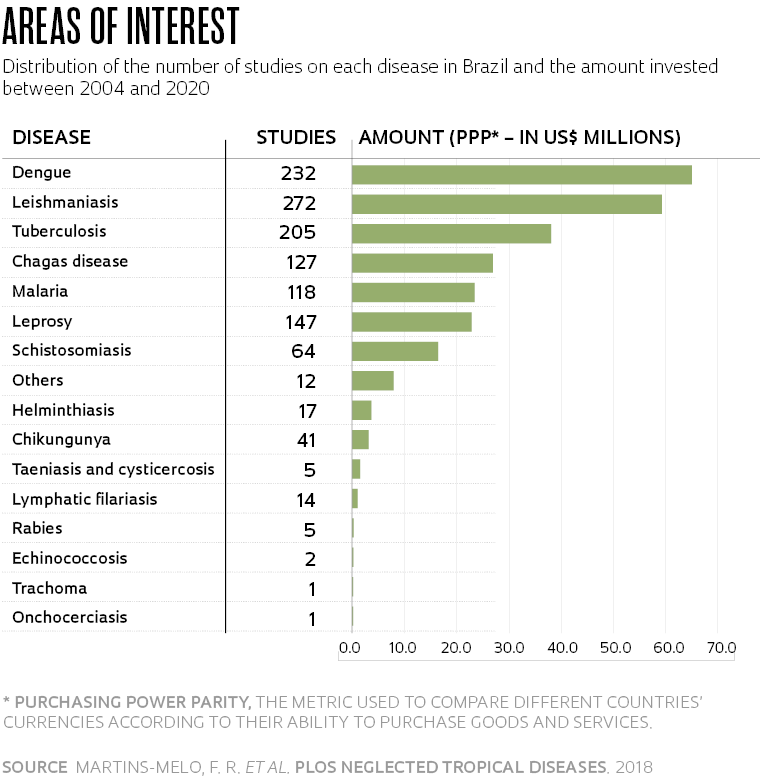Public investments in studies on neglected tropical diseases, those that attract little interest from the pharmaceutical industry because they primarily affect poor populations and countries, have decreased significantly over the last two decades in Brazil, according to a survey conducted by researchers at the Ministry of Health (MS), the University of Brasília (UnB), and the Coração Hospital, in São Paulo. The group analyzed funding trends for studies on diseases such as Chagas disease, leprosy, and schistosomiasis between 2004 and 2020 based on data from the Department of Science and Technology (DECIT), an agency linked to the MS that funds strategic research for the Brazilian Unified Health System (SUS) independently or in partnership with other institutions.
Brazil invested approximately US$230.9 million in 1,158 research projects during the same period. The values were updated for 2021 and adjusted for purchasing power, a metric used to equalize different countries’ currencies according to their ability to purchase goods and services. The MS accounted for 69.8% of this value. The remaining investment came from sector funds (14.7%), state-run research support agencies (11.5%), and the Ministry of Education and the Ministry of Science, Technology, and Innovation (0.5%). The Bill & Melinda Gates Foundation, a philanthropic organization headquartered in the United States and recognized for its efforts in fighting diseases such as malaria, contributed 3.6% of the funds allocated for disease research in Brazil—the funds, in this case, went towards work related to dengue and tuberculosis.
According to the article published in March in the PLOS Neglected Tropical Diseases journal, both the amounts invested and the number of studies supported varied greatly over the years, even in periods with greater funding for science, with sharper drops in transition periods within the federal government. “The creation of new knowledge to control these diseases depends on continuous and predictable investing,” says chemist Luiz Carlos Dias, of the Institute of Chemistry at the University of Campinas (UNICAMP), who did not participate in the study. “In Brazil, however, it seems that it is still seen as a government policy, and not a state policy, where more or less funding is received depending on the new administration,” adds the researcher and coordinator of an international consortium of institutions for the development of new drugs for tropical parasitic diseases, supported by FAPESP.
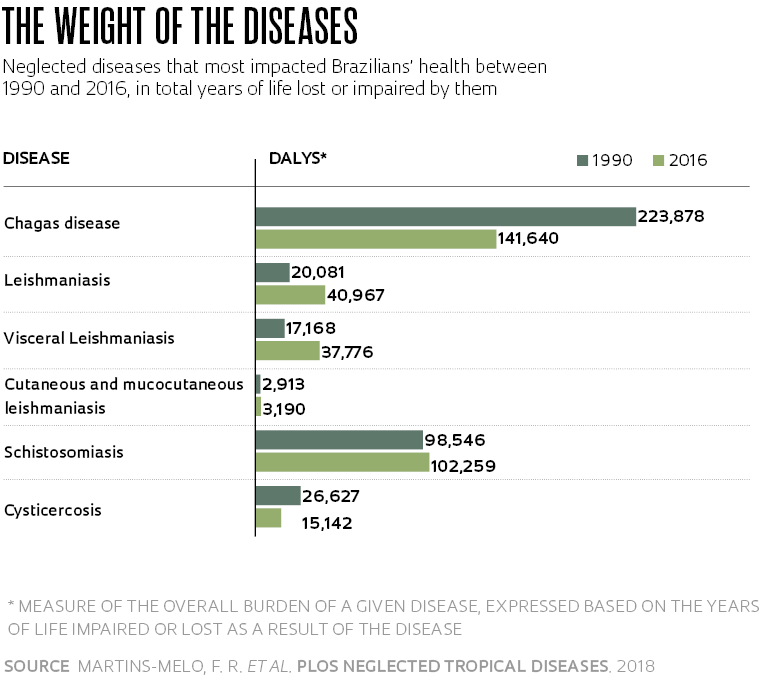
The pandemic exacerbated this scenario. The reallocation of money and manpower to fight the novel coronavirus has undercut support for research on these diseases. In 2020, a total of US$3.8 million was spent, which is 73% less than in 2019. The reporter contacted the MS for a stance on the survey findings but did not get a response before publication.
Neglected diseases affect approximately 1.7 billion people worldwide, mainly in Africa, Southeast Asia, and Latin America, according to the World Health Organization (WHO). Brazil is still vulnerable to several of them, especially dengue, leprosy, and leishmaniasis, but has managed to reduce others, such as schistosomiasis and Chagas disease. Of the 20 diseases that make up this group, only two are not present in Brazil: dracunculiasis, caused by the Guinea worm parasite, which produces blisters, mainly on the legs; and African trypanosomiasis, triggered by different subspecies of the Trypanosoma brucei, transmitted by the tsetse fly (Glossina), and which, in humans, affects the nervous system and can lead to coma and death. Individuals in vulnerable situations, without access to basic sanitation, healthcare, and education, are the most heavily affected. It is estimated that up to 10,000 Brazilians die per year because of a neglected disease, especially in the North and Northeast regions.
Coordinator of the Ministry of Science’s National Leprosy and Disease Elimination Program from 2004 to 2007 and 2011 to 2016, Dr. Rosa Castália reminds us that these diseases usually shorten the productive life of their victims or trigger chronic conditions that require assistance, such as lifelong, expensive, and complex healthcare services. Examples of this are heart disease caused by Chagas disease and epilepsy associated with cysticercosis.
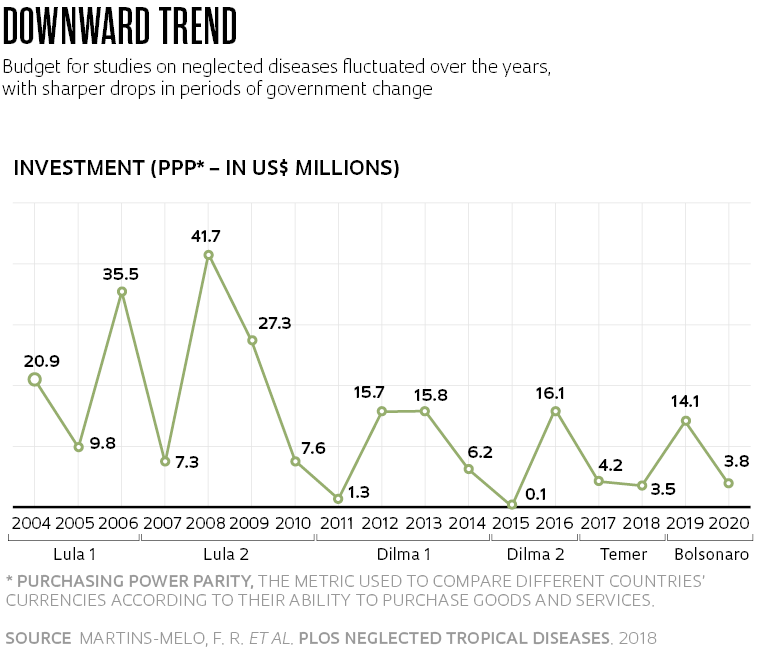
Pharmaceutical companies generally show little interest in developing drugs to fight these diseases—because they affect poor populations, such drugs would have little economic exploitation potential. “It is important that the affected countries invest in their own solutions for prevention, diagnosis, and treatment,” says Dias.
The figures described in the study published in PLOS Neglected Tropical Diseases show that Brazil’s investments are modest in comparison to other countries. In 2018, for example, they totaled US$3.5 million, which is 16.6% less than the previous year. Over the same period, the United States invested nearly US$1.8 billion, while global funding reached US$4.05 billion, 7% more than in 2017, according to data released by the organization G-Finder, which monitors investments in research and development (R&D) for healthcare products and technology (see Pesquisa FAPESP issue no. 302).
Admittedly, the G-Finder survey considers diseases no longer classified as neglected diseases by the WHO, such as malaria, which has received more investments in recent years. In 2021, the WHO announced the first immunization to fight the disease. Developed by British pharmaceutical company GlaxoSmithKline, the vaccine acts against Plasmodium falciparum, the most lethal of the five parasites that cause malaria.
In Brazil, research on dengue, leishmaniasis, and tuberculosis received the most funding between 2004 and 2020. The three diseases accounted for 56.1% of the studies conducted and 60.2% of the funds invested. “From the list of neglected diseases, dengue was perhaps the one with the most public research planning and important developments, including a candidate vaccine compound being developed by the Butantan Institute,” says Dias. On the other end, diseases such as onchocerciasis, echinococcosis, and trachoma accounted for only 0.3% of the research and 0.1% of the funds invested—between 2008 and 2019, Brazil recorded more than 191,000 cases of trachoma.
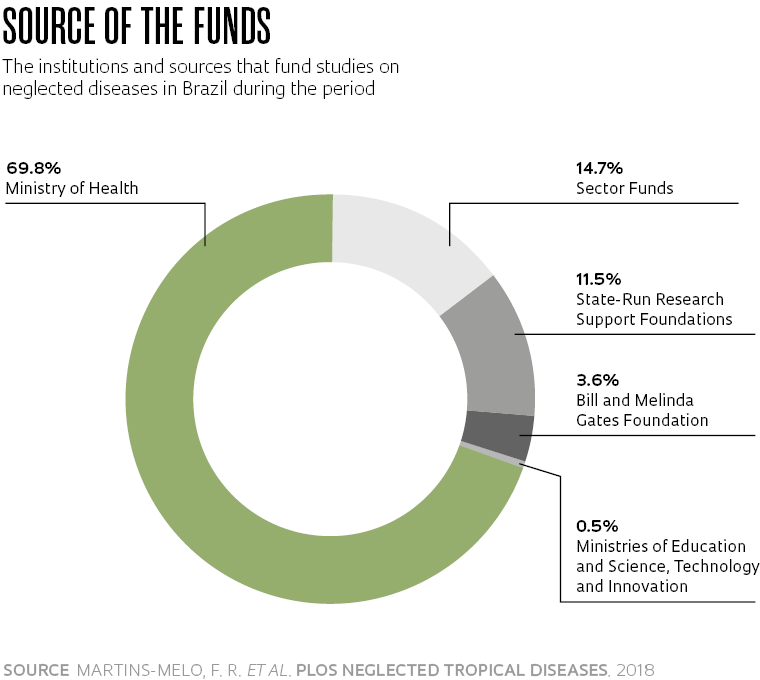
Investment in research is considered essential to increasing knowledge that will provide the basis for implementing, monitoring, and evaluating health policies. With neglected diseases, however, it seems there is a lack of coordination between healthcare needs and study targets. Diseases such as chikungunya and malaria have the second and third highest prevalence, respectively, among neglected diseases in Brazil. Between 2004 and 2020, however, they occupied the 9th and 5th position in terms of research funding.
It is unclear why chikungunya, which has affected more than 250,000 Brazilians and whose mortality rate is similar to dengue’s, has had fewer studies. Researchers suspect that it is because the disease emerged more recently in Brazil, with the first cases of internal transmission recorded in 2014. For the others, such as taeniasis and cysticercosis, it is likely that the lack of public policies for fighting the diseases has made the scientific community simply not interested in studying them. “In my opinion, the more socially vulnerable a given population is, the more neglected the diseases that affect them,” says Castália. “In Brazil, for example, one of the most overlooked diseases is onchocerciasis, which exclusively affects the Yanomami population.”
According to immunologist João Santana da Silva, of the Ribeirão Preto Faculty of Medicine at the University of São Paulo (FMRP-USP), the study findings show a lack of government planning in this area. “We are always chasing the issues, prioritizing the most urgent diseases at the moment, without resolving the problems caused by the previous ones,” he says. Parasitologist Angela Kaysel Cruz, also from FMRP-USP, adds that certain diseases tend to be more neglected than others, which can result in imbalanced research investments. “Some have a harder time attracting the interest of researchers, who prefer to concentrate their efforts on topics for which there is more funding and interest from the international community,” she says. This phenomenon creates a vicious cycle, according to Silva, in which a lack of funding for research on a particular disease results in scientists having little interest in studying it. “With this, you stop producing new knowledge and training scientists who specialize in these diseases.”


